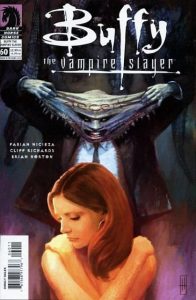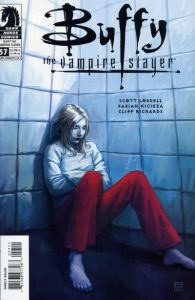A lot of comic series whimper to their conclusion, but “Buffy the Vampire Slayer Classic” is not one of them. It saves the best for last, ironically by going back to the start of the timeline and filling in the events between “The Origin” and “Welcome to the Hellmouth” (Season 1, episode 1) in its final three arcs. Here’s a look at the last two, which — like “Viva Las Buffy!” (Issues 51-54) — are rare spin-off yarns that qualify as essential reads if you want a full picture of Buffy’s hero’s journey.
“Slayer, Interrupted” (Issues 56-59, April-July 23)
I remembered the previous arc (“Viva Las Buffy!”) more, but Scott Lobdell’s swan song, “Slayer, Interrupted,” is better, and it’s an even more crucial chapter in “Buffy” lore. The controversial “Normal Again” (6.17) introduced the fact that Buffy was in a mental institution after she was called to Slayerdom but before coming to Sunnydale. The episode has so many engaging aspects that it’s easy to overlook the fact that we don’t learn why she entered the institution, nor why she left (assuming you don’t subscribe to the theory that she never left, and that the events of the Buffyverse are all in her head).
“Slayer, Interrupted” fleshes out this period with a wonderful character piece for Buffy. (“Viva Las Buffy!,” you’ll recall, is more of a Pike piece.) Despite having tapped into her Slayer side in Vegas, Buffy – having not heard from the Watchers’ Council since Merrick’s death – mulls the notion that she may have been given a reprieve, and she doesn’t have to be the Slayer after all. Joyce and Hank think Buffy needs psychological treatment, and this isn’t a clichéd story where our hero, who only we know is perfectly sane, is dragged into the asylum kicking and screaming.
Lobdell continues to undercut clichés the rest of the way, as he effectively shows this 15-year-old wavering between two very different possible futures: Slayer or normal person. Buffy likes the peace of the facility, and chooses to ignore a fellow patient’s rantings about being the bride of a demon. Then she checks it out, and — essentially with a long sigh — realizes she has to save the day again.
I like the twist where one of the doctors turns out to be a former Watcher who is watching Buffy (off the clock, as it were). In the arc’s final issue, she has things to say about destiny that provide excellent connective material for Buffy’s Hemery-to-Sunnydale period:
“It was no coincidence that you attended the one high school in all of Los Angeles that was infested by Lothos and his undead hordes. It didn’t just happen that you found yourself in Vegas, battling the freaks in that casino. It was no mistake you came here. You are now a creature of destiny, Buffy Summers. Slayers are always where they most need to be.”
“Slayer, Interrupted” also includes a side plot, written by Fabian Nicieza, that could be called “Watcher, Interrupted.” The Council requires Giles to go through a test – similar to Luke Skywalker entering the tree cave on Dagobah – where he proves he has shed his “Ripper” past. Only then is he confirmed as the Watcher of the current Slayer. When we consider the arrogance displayed by the Council in episodes such as “Helpless” (3.12) and “Checkpoint” (5.12), it jibes that they’d leave the active Slayer in the lurch for six months.
Angel and Whistler also spy on Buffy in this arc, and in another side “plot” that lasts only one page, we see Willow shrinking away from the Cordettes, who are poking fun at her. Rather than being random, the inclusions of Buffy’s future allies is poignant. We get a sense that these people’s lives will have new meaning once Buffy arrives in them. I got a similar feeling watching “The Wish” (3.9), although that episode has an alternate spin, showing us a world where Buffy doesn’t come to Sunnydale.
On my first read of this arc, I rebelled against the notion of Dawn being in it, even writing a letter to the comic reminding them that Dawn does not exist until Season 5. Editor Scott Allie argued that if Buffy were to recount the events of this time period, her stories would include Dawn. So from a certain point of view, as Obi-Wan Kenobi would say, Dawn does exist at this time. (Her appearance would be bizarre for a newcomer reading the “Buffy” saga chronologically, but such a scenario is unlikely.) Dawn’s discovery of Buffy’s diary isn’t the “real” spark that sends Buffy to the asylum. But when one considers the theme of destiny that permeates “Slayer, Interrupted,” it fits.
5 stars

“A Stake to the Heart” (Issues 60-63, August-November 2003)
Nicieza is on solo writing duty for the final arc of the classic “BTVS” monthly. He examines one last unturned stone in the period between “The Origin” and Season 1: Buffy’s (and Dawn’s, if you will) transition from a two-parent home to a single-mom home, and in a new town, no less. The writer carries over the “destiny” theme from “Slayer, Interrupted” in several ways, most notably the surprising (and unfortunately under-explained) fact that Giles moves to Sunnydale before the Summers women decide to move there.
Each of the four issues examines a feeling that a child would likely experience when her parents get divorced and she moves to a new town with one of them. It’s not “shock, denial, anger, acceptance,” but rather deceit, guilt, abandonment and trepidation. Buffy feels her parents had been dishonest with her, she feels like she’s responsible for their split, she feels abandoned by her dad, and she feels anxious about the start of her life’s new chapter.
As per “Buffy” formula, monsters are on hand to represent each of these four feelings, with Angel having mistakenly summoned the Malignancy Demons in a spell where he was attempting to alleviate Buffy’s depression. (So that’s yet another thing about his pre-Sunnydale days he never shares with Buffy.) The concept works in a broad sense. For example, I can relate to Buffy’s trepidation about moving to a new town. (Is it the right choice? What if I make the wrong choice? Would it be simpler to just not make a choice?)
But the specific battles are confusing because the monster exists somewhat in reality and somewhat as an ephemeral spirit. Buffy working through her feeling parallels her dispatching of the monster. Although the art by Cliff Richards (pencils)/Will Conrad (inks) and coloring by Michelle Madsen – who favors dark oranges and reds of twilight time – is good, it’s unclear to me when and if Buffy is literally fighting these Malignancy Demons, and when and if it’s all in her head.
In a side trip in the trepidation chapter, Willow and Xander are on the phone wondering if they should do something that day, but ultimately they decide do nothing. This is because they are influenced by the Malignancy Demon, but it also works to illustrate the wider notion that their lives will be infused with purpose when Buffy arrives – much like Buffy’s life is infused with purpose when she receives her Slayer powers.
4 stars
So “BTVS Classic” concludes with its three most important arcs, having filled in the gap between “The Origin” and “Welcome to the Hellmouth” with stories I mostly didn’t know I wanted until after I read them. It drastically improved from its earliest issues, which were crammed into the Season 3 timeline and were shy about tackling big issues in the characters’ lives. As good as the Fassbender/Pascoe work in the middle of the run was, I give an edge to the Lobdell/Nicieza period, as these are not only good stories, but also essential stories.
Click here for an index of all of John’s “Buffy” and “Angel” reviews.


